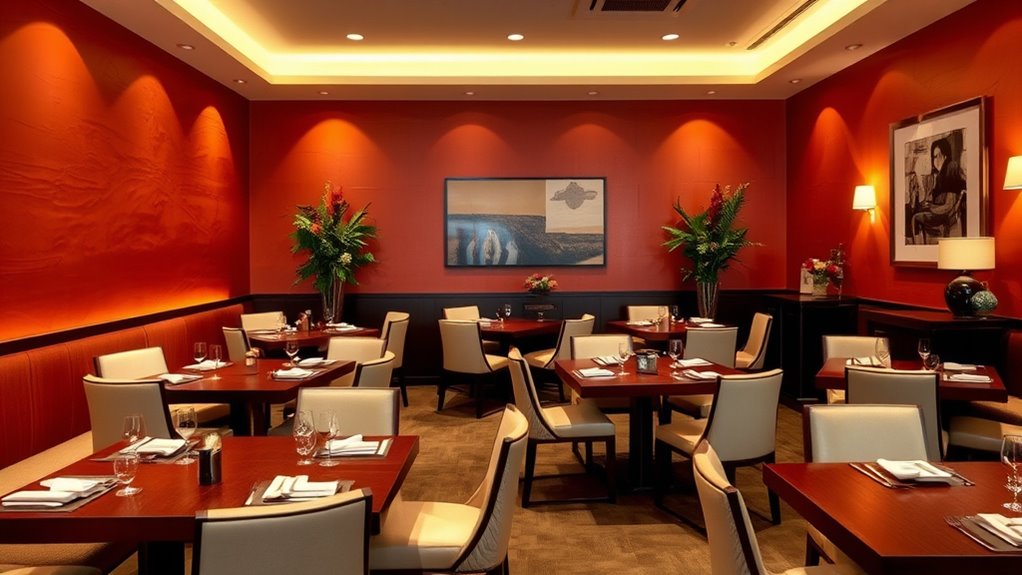To boost your appetite in the dining room, choose warm accent wall colors like red or cheerful yellow, which energize and stimulate hunger. Earth tones such as soft browns and greens create a cozy, inviting atmosphere, while deep greens and olive shades promote a natural, calming vibe. Subtle neutrals add elegance and balance, making your space versatile. Keep exploring to discover more color strategies that can turn your dining area into a food-friendly haven.
Key Takeaways
- Use warm reds or brick tones on accent walls to psychologically stimulate hunger and create an energetic dining environment.
- Incorporate cheerful yellows to boost mood and encourage social interaction, increasing appetite.
- Opt for earthy tones like warm browns and muted greens to evoke comfort and stimulate casual dining.
- Combine neutral shades with bold accents to balance appetite-enhancing colors while maintaining versatile decor.
- Incorporate natural materials and lighting to enhance warm and inviting atmospheres that promote longer, satisfying meals.
Warm Reds and Their Effects on Appetite
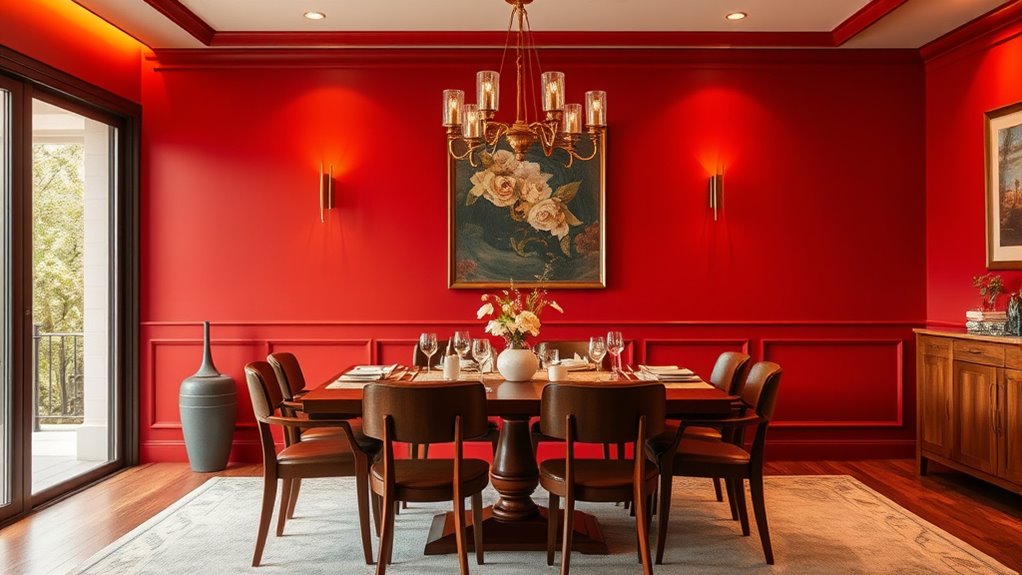
Warm reds are known to stimulate your appetite, making them a popular choice for dining areas. This effect stems from the psychological impact of color psychology, where red is linked to excitement and energy, encouraging you to eat more. When you see warm reds on an accent wall, it triggers a subconscious response that can increase your hunger. Studies show that red enhances feelings of warmth and comfort, which can make your dining space feel more inviting. By choosing this hue, you’re leveraging its ability to influence mood and behavior, subtly encouraging longer, more social meals. Additionally, incorporating warm reds can evoke emotional warmth, further enhancing the cozy atmosphere of your dining room. Keep in mind, the intense nature of red can also evoke urgency or excitement, so balance it with other design elements to create a harmonious dining environment.
Inviting Earth Tones for a Cozy Dining Atmosphere
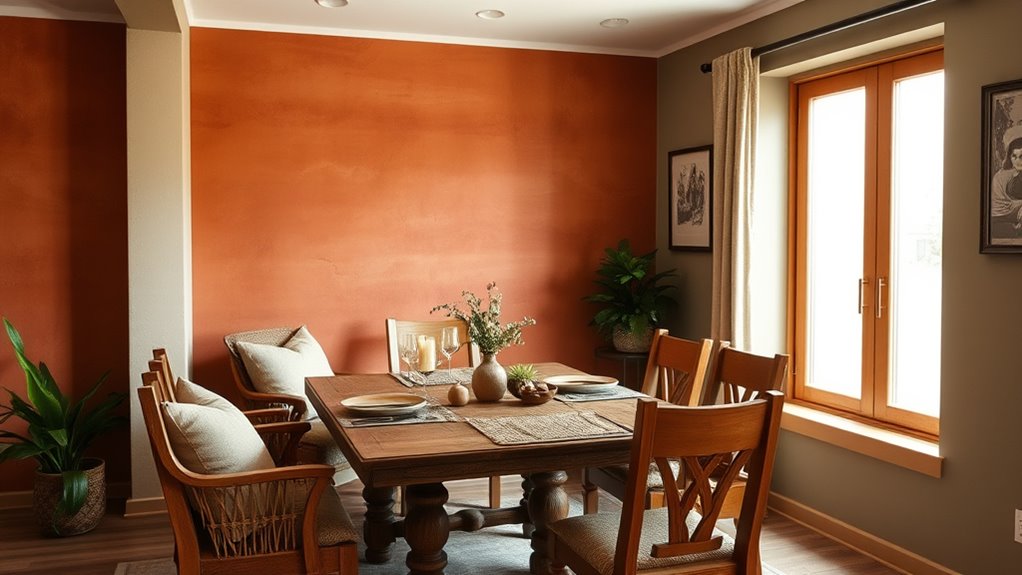
Earth tones create an inviting and comfortable dining atmosphere by bringing a sense of nature indoors. These colors, like warm browns, soft beiges, and muted greens, foster coziness and relaxation. To maximize their effect, consider your dining room lighting; soft, warm lighting enhances the earthy hues, making the space feel even more welcoming. Proper furniture placement also plays a role: positioning your table centrally and using natural materials like wood or rattan complements the earth tones, creating harmony. Keep the space uncluttered, allowing the colors to breathe. Incorporating color psychology insights can help you select shades that stimulate appetite and conversation. By blending inviting earth tones with thoughtful lighting and furniture arrangement, you’ll craft a cozy environment that encourages lingering meals and good conversation.
Bright and Cheerful Yellows to Stimulate Hunger
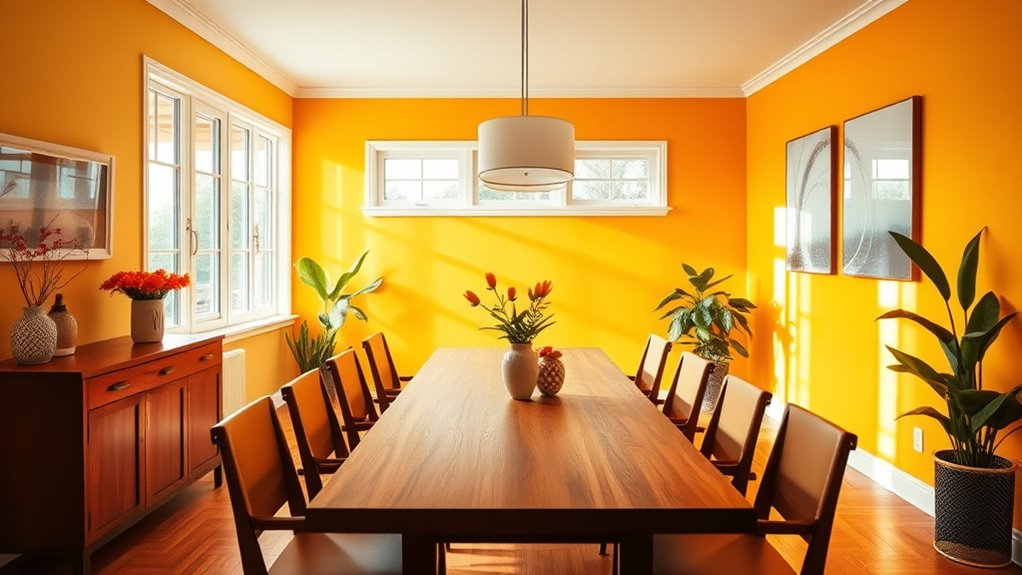
Bright and cheerful yellows are a fantastic choice for stimulating appetite and creating an energetic dining space. In terms of color psychology, yellow boosts mood and encourages social interaction, making your dining room more inviting. This vibrant hue can transform your dining space into a lively environment that promotes conversation and hunger. To enhance the dining room ambiance, consider these tips:
Bright yellow tones energize your dining space and encourage lively conversations.
- Use yellow as an accent wall to draw attention without overwhelming.
- Pair yellow with neutral tones for balance and warmth.
- Incorporate natural light to intensify the cheerful effect.
- Add yellow accessories or artwork to complement the main color.
- Be mindful of the emotional impact of your color choices to ensure a positive and welcoming atmosphere.
Rich Olive and Deep Greens for a Natural Feel

Rich olive and deep greens bring a calming, natural vibe to any space, making them perfect for creating a serene environment. To enhance this effect, consider decorative accent ideas like incorporating natural materials or botanical artwork that complement the green tones. Wall texture options such as textured plaster, faux wood panels, or raised patterns add depth and interest, emphasizing the earthy feel. These textures work well with rich greens, making your accent wall stand out while maintaining a soothing atmosphere. You can also experiment with matte or satin finishes to subtly reflect light, further enhancing the natural ambiance. Additionally, understanding self watering plant pots can inspire the integration of live greenery, promoting a lively and healthy environment. Overall, these colors and textures foster a tranquil setting that stimulates your appetite in a subtle, inviting way.
Subtle Neutrals and Their Versatile Appeal
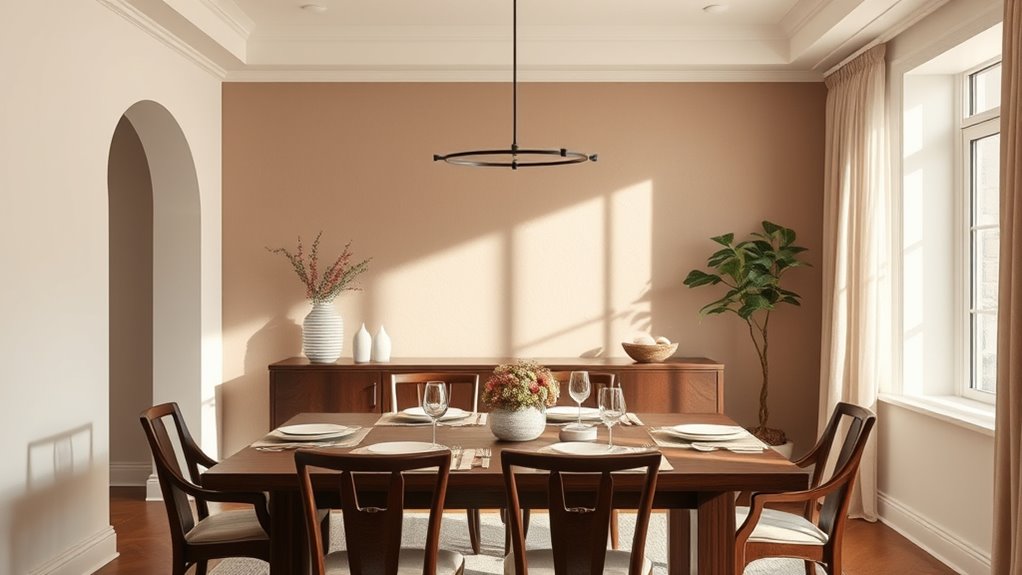
Subtle neutrals are an excellent choice for versatile accent walls because they seamlessly complement various color schemes and interior styles. These shades create a calming atmosphere while allowing other design elements to stand out. In terms of color psychology, neutrals evoke feelings of stability and sophistication, making your dining space feel inviting and balanced. They also align with current interior design trends that favor minimalism and timeless elegance. To maximize their appeal, consider pairing neutrals with bold accents or textured materials. Here are some ideas:
- Soft beige or taupe for warmth
- Light gray for modern sophistication
- Creamy whites for brightness
- Greige for a trendy, versatile look
Additionally, understanding color harmony can help you select neutrals that enhance your overall decor.
Frequently Asked Questions
How Do Accent Wall Colors Influence Mood During Meals?
You might wonder how colors affect your mood during meals. Color psychology shows that certain hues can enhance mood and influence appetite. Bright, warm colors like red or orange often stimulate hunger and create a lively atmosphere, while calmer shades like blue promote relaxation. By choosing the right accent wall colors, you can boost mood enhancement and make your dining experience more enjoyable and inviting.
Can Specific Colors Improve Digestion in Dining Spaces?
You might wonder if specific colors can improve digestion in dining spaces. Color psychology suggests that warm, earthy tones like soft yellows and muted oranges can enhance your dining ambiance, potentially aiding digestion by creating a cozy, relaxed atmosphere. These colors stimulate appetite without overwhelming the senses, helping you enjoy your meals more comfortably. So, choosing the right hues can subtly influence your overall dining experience and digestion.
Are There Cultural Color Preferences That Affect Appetite?
Imagine you’re in a bustling market, where cultural color symbolism guides your choices. You notice that regional dining preferences influence the colors people prefer, affecting appetite. In some cultures, reds and oranges stimulate hunger, while in others, cool blues and greens promote calmness. Recognizing these cultural nuances helps you select accent wall colors that resonate with local customs, enhancing the dining experience and encouraging appetite naturally.
What Lighting Best Complements Accent Wall Colors to Enhance Appetite?
You should choose lighting with a warm color temperature, around 2700K to 3000K, to complement your accent wall colors and boost appetite. Opt for fixtures with wall paint finishes like matte or satin, which diffuse light softly and reduce glare. Proper lighting enhances the vibrancy of your wall paint finishes, creating an inviting atmosphere that stimulates appetite. Adjust lighting intensity to highlight your accent wall without overpowering the space.
How Do Personal Color Associations Impact Dining Room Color Choices?
Think of your dining room as a canvas painted by your personal color psychology. Your individual color preferences shape how you feel and eat in that space. When choosing colors, consider how certain hues evoke hunger or comfort for you. Personal associations act like a compass, guiding you to colors that make your dining experience more enjoyable. Trust your instincts, and select shades that resonate with your unique taste and emotional response.
Conclusion
Choosing the right accent wall color can gently encourage lingering at your dining table, making every meal a little more special. Whether you opt for warm reds, earthy tones, or cheerful yellows, these shades create an inviting ambiance that naturally invites conversation and enjoyment. Remember, the perfect hue isn’t just about appetite—it’s about crafting a space where everyone feels comfortable and enthusiastic to share. So, trust your instincts and let your walls work their subtle magic.
